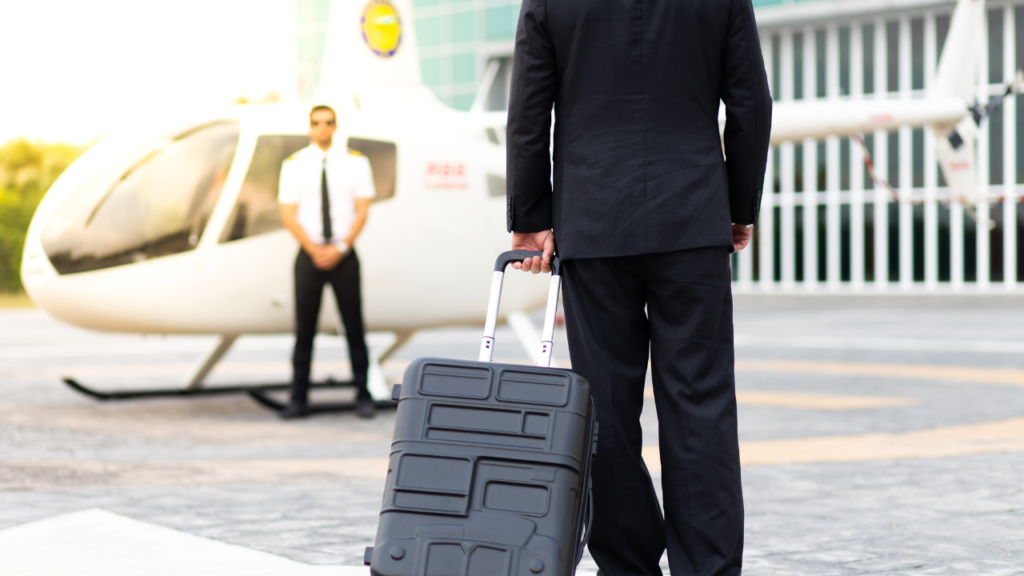VIP Protection in the Air: Tailoring Security for High-Profile Passengers

In the world of corporate aviation, ensuring the safety and security of high-profile passengers is paramount. VIP protection in the air presents unique challenges that demand specialized knowledge, skills, and strategies. This blog post delves into the intricate world of airborne VIP protection, exploring how security professionals can tailor their approaches to safeguard high-profile individuals during air travel.
The Unique Landscape of Airborne VIP Protection:
VIP protection in aircraft differs significantly from ground-based security operations. The confined space, limited resources, and dynamic environment of air travel create a distinct set of challenges. Recent statistics show a 20% increase in security incidents involving VIPs on private aircraft, underlining the growing importance of specialized airborne protection.
Key Considerations in Airborne VIP Protection:
1. Pre-Flight Security Measures:
– Comprehensive threat assessments specific to air travel routes
– Secure transportation to and from airports
– Discreet yet thorough passenger and luggage screening
2. Aircraft Security:
– Detailed security sweeps of the aircraft before boarding
– Secure zones within the aircraft for VIP passengers
– Advanced onboard surveillance and monitoring systems
3. In-Flight Security Protocols:
– Constant situational awareness throughout the flight
– Clear communication channels between security personnel and flight crew
– Protocols for handling mid-air security threats or medical emergencies
4. Privacy and Discretion:
– Balancing visibility of security measures with VIP privacy concerns
– Managing media attention and potential security leaks
– Secure communication methods for VIPs during flight
Best Practices for Tailoring VIP Protection in the Air:
1. Personalized Risk Assessments:
– Conduct thorough evaluations of each VIP’s specific threat profile
– Analyze past incidents and potential new threats
– Tailor security measures to individual VIP preferences and requirements
Case Study: A security team protecting a high-profile CEO implemented a personalized risk assessment protocol, resulting in a 30% reduction in potential security risks during air travel.
2. Advanced Technology Integration:
– Utilize cutting-edge surveillance and communication technologies
– Implement secure, encrypted communication systems
– Employ AI-driven threat detection systems for real-time risk analysis
3. Specialized Team Composition:
– Assemble teams with diverse skills including close protection, aviation security, and medical expertise
– Ensure team members are trained in air-specific security protocols
– Maintain a flexible team structure adaptable to different aircraft types and VIP needs
4. Collaborative Security Approach:
– Foster close coordination between VIP protection teams and aircraft crew
– Establish clear chains of command and decision-making processes
– Conduct joint training exercises with flight crews and ground staff
5. Discreet Protective Equipment:
– Utilize non-obvious protective gear suitable for air travel
– Implement concealed communication devices
– Ensure equipment compliance with aviation regulations
6. Cultural Sensitivity and Etiquette:
– Train security personnel in VIP etiquette and cultural norms
– Develop protocols for interacting with VIPs from diverse backgrounds
– Balance security needs with VIP comfort and preferences
Expert Insight: “In airborne VIP protection, the key is to be invisible yet omnipresent,” notes James Carter, veteran VIP protection specialist. “Our goal is to ensure the VIP feels secure without feeling restricted.”
7. Emergency Response Planning:
– Develop comprehensive emergency protocols specific to in-flight scenarios
– Conduct regular drills simulating various airborne emergencies
– Establish relationships with international emergency response teams
8. Secure Ground Operations:
– Implement robust security measures during refueling and layovers
– Coordinate with local security forces at destination airports
– Ensure secure transportation and accommodation arrangements at all stops
Technological Innovations in Airborne VIP Protection:
1. Biometric Access Control:
– Implement advanced biometric systems for secure aircraft access
– Utilize facial recognition for real-time threat identification
2. Secure Cabin Communication Systems:
– Deploy encrypted, tamper-proof communication networks
– Implement secure video conferencing capabilities for in-flight business needs
3. Advanced Air Purification Systems:
– Utilize HEPA filtration and UV sterilization to protect against airborne threats
– Implement real-time air quality monitoring systems
4. Smart Textiles for Security Personnel:
– Incorporate wearable technology for discreet communication and vital sign monitoring
– Utilize clothing with integrated ballistic protection suitable for air travel
Legal and Ethical Considerations:
VIP protection in the air must navigate a complex landscape of legal and ethical considerations:
1. International Air Law Compliance: Ensuring security measures align with various national and international aviation regulations
2. Privacy Laws: Balancing security needs with stringent privacy protection requirements
3. Use of Force Protocols: Developing clear guidelines for security personnel in various scenarios
4. Diplomatic Considerations: Understanding and navigating diplomatic immunities and international protocols for VIP travel
Training for Airborne VIP Protection:
Specialized training is crucial for effective VIP protection in air travel environments. Our Corporate Aircraft VIP Protection Course includes a comprehensive module on airborne security, covering:
– Aircraft-specific security protocols and best practices
– Advanced threat assessment techniques for air travel
– In-flight emergency response and crisis management
– Cultural sensitivity and VIP etiquette in aviation contexts
This training equips security professionals with the unique skill set required to provide top-tier protection for VIPs during air travel.
VIP protection in the air requires a delicate balance of robust security measures, discretion, and adaptability. As the risks evolve, so must the strategies and technologies employed to safeguard high-profile individuals during air travel. By tailoring security approaches to the unique demands of airborne environments, protection specialists can ensure the safety and peace of mind of their VIP clients.
Are you ready to elevate your skills in airborne VIP protection? Enroll in our comprehensive Corporate Aircraft VIP Protection Course and master the art of securing high-profile individuals in the challenging environment of air travel. Visit to learn more and register today. Don’t let your VIP protection skills remain grounded – soar to new heights in airborne security expertise!


